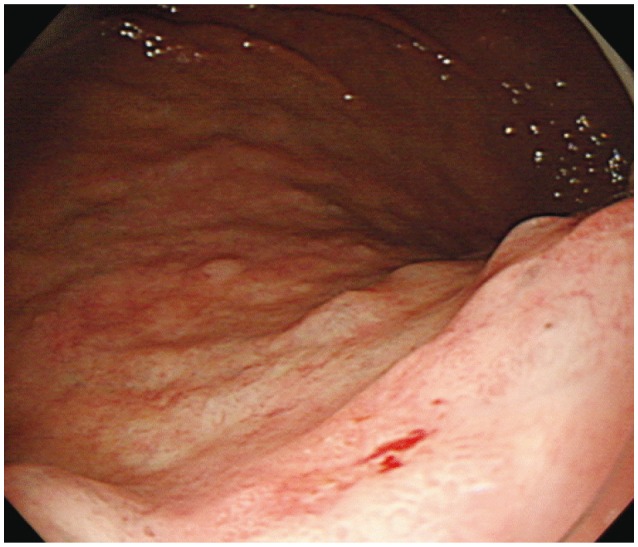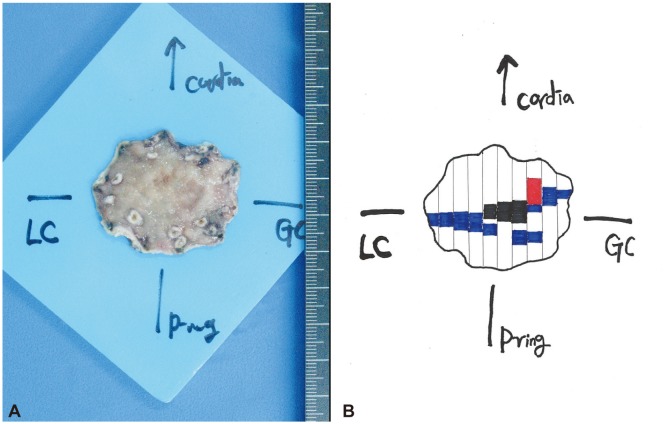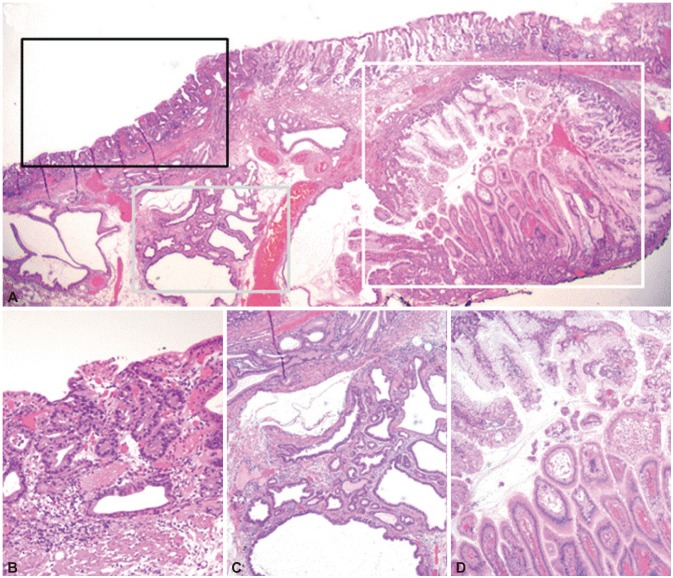Clin Endosc.
2013 Sep;46(5):568-571.
A Case of Gastric Inverted Hyperplastic Polyp Found with Gastritis Cystica Profunda and Early Gastric Cancer
- Affiliations
-
- 1Department of Internal Medicine, Gangneung Asan Hospital, University of Ulsan College of Medicine, Gangneung, Korea. saiah@naver.com
- 2Department of Pathology, Gangneung Asan Hospital, University of Ulsan College of Medicine, Gangneung, Korea.
Abstract
- A gastric inverted hyperplastic polyp is a rare type of gastric polyp and is characterized by downward growth of a variety of mucosal components into the submucosa. The polyp consists of columnar cells resembling foveolar epithelium and pyloric gland epithelium and can coexist with gastritis cystica profunda. Frequently, adenocarcinoma can coexist, but the relation is not clear. A 77-year-old male underwent endoscopic submucosal dissection due to early gastric cancer. A gastric inverted hyperplastic polyp was found in the removed specimen and gastric cystica profunda was also found. We report a case of gastric inverted hyperplastic polyp coexisting with gastric cystica profunda and gastric adenocarcinoma.
MeSH Terms
Figure
Reference
-
1. Kamata Y, Kurotaki H, Onodera T, Nishida N. An unusual heterotopia of pyloric glands of the stomach with inverted downgrowth. Acta Pathol Jpn. 1993; 43:192–197. PMID: 8493869.
Article2. Choi MS, Jin SY, Kim DW, Lee DW, Park SM. A case of gastric inverted hyperplastic polyp associated with gastritis cystica profunda and early gastric carcinoma. Korean J Pathol. 2007; 41:55–58.3. Kono T, Imai Y, Ichihara T, et al. Adenocarcinoma arising in gastric inverted hyperplastic polyp: a case report and review of the literature. Pathol Res Pract. 2007; 203:53–56. PMID: 17097828.
Article4. Sobin LH. Inverted hyperplastic polyps of the colon. Am J Surg Pathol. 1985; 9:265–272. PMID: 4014540.
Article5. Cho HJ, Kim JE, Jeong BJ, et al. A case of gastric adenocarcinoma arising from gastritis cystica profunda. Korean J Gastrointest Endosc. 2004; 28:237–241.6. Jo MA, Kim SH, Kim SH, et al. A case of gastritis cystica profunda with early gastric cancer. Korean J Med. 2004; 67:78–82.7. Kim JY, Hur H, Cho YK, Han SU. gastric cancer associated with gastritis cystica profunda in patients without previous gastric surgery. J Korean Surg Soc. 2010; 79(Suppl 1):S26–S30.
Article8. Lee HJ, Lee TH, Lee JU, et al. Clinical features of gastritis cystica profunda in patients without history of gastric surgery (gastric cancer patients vs. non-cancerous patients). Korean J Med. 2006; 71:511–517.9. Moon SY, Kim KO, Park SH, et al. Gastritis cystica profunda accompanied by multiple early gastric cancers. Korean J Gastroenterol. 2010; 55:325–330. PMID: 20697192.
Article
- Full Text Links
- Actions
-
Cited
- CITED
-
- Close
- Share
- Similar articles
-
- A Case of Gastric Inverted Hyperplastic Polyp Associated with Gastritis Cystica Profunda and Early Gastric Carcinoma
- A Case of Gastritis Cystica Profunda Showing Giant Gastric Mucosal Fold
- A case of gastritis cystica profunda with early gastric cancer
- Gastritis Cystica Profunda: A case report
- A Case of Gastric Adenocarcinoma Arising from Gastritis Cystica Profunda




